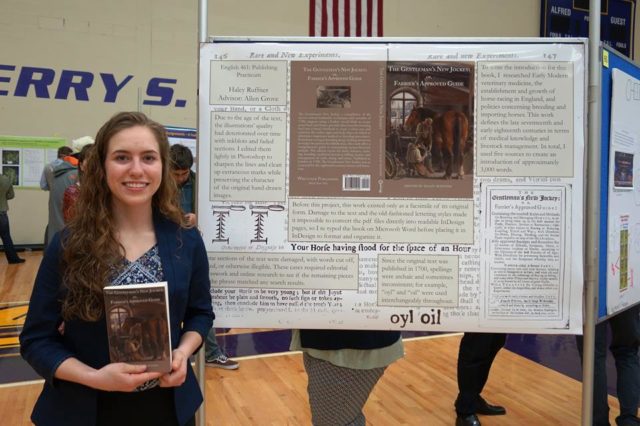
The Academic Equestrian: Republishing
Haley Ruffner, our collegiate blogger, makes sure all of her schoolwork relates to horses — including republishing a 1700 text on horse care.
As my sophomore year at Alfred draws to a close, one week out from finals week and IHSA Nationals (conveniently falling on the same week), every project I’ve put off looms threateningly. I have one week to be fully Nationals-ready for horsemanship and reining, and one week to finish all of my portfolios, revisions, and final exams. For one class, however, I have already completed the final project: republishing a book.
For my Publishing Practicum class, wherein we learn how to use InDesign (a publishing software) to format and re-publish an out-of-copyright book, my professor gave all of us free rein in choosing the work we wanted to publish. Naturally, I chose a horse-related one: a manual on animal husbandry covering horse training, veterinary medicine, caring for various farm animals, and killing vermin.
Since the work I chose, titled The Gentleman’s New Jockey, was published in 1700, the quality of the original text was poor and fraught with old-fashioned lettering styles that made it impossible to translate directly into a readable PDF file. The workaround is to re-type the entire thing (all 200-odd pages) in Microsoft Word, and from there import the text to InDesign where I could format each section and add page numbers and running headers.
The techniques and technology recommended to “cure” various diseases made for both an interesting and mildly horrifying read. To remove excess sweat from your horse, the authors recommend using a broken sword blade. There are directions for filling in the hollows above an aging horse’s eyes to make him appear younger to a buyer, instructions on how to carve a shape in a horse’s forehead and shove lead under the skin to create a white star, lucky dates on which to administer different medical procedures, and how to blind mice and stop weasels from sucking eggs.
Beyond creating the book itself, the project also involved researching early modern veterinary medicine, breeding and horse-racing policies, and the horse industry in late-seventeenth and early-eighteenth century England. Using this information, I wrote an approximately 3,000-word introduction that is placed before the actual text in my book.
Last week, I presented the finished product at Alfred University’s Undergraduate Research Forum, where I was barely recognizable to most of my peers and professors in business clothes, missing my usual jeans and boots. The book is available for purchase on Amazon (the profit from any copies sold first go to offset the cost of publishing, and any remaining goes towards Alfred’s Visiting Writers fund). I am well-acquainted with late nights in the library, and my usual chair in the computer lab probably has a permanent indent of my seat bones — having the opportunity to feed my inner horse-crazy girl while pursing my major and future career has been stressful but incredibly rewarding.
Haley is the author of Horse Nation’s “Academic Equestrian” series, following her collegiate experience as she balances her studies with participation on the varsity equestrian team and time with her own horse. Catch up on past columns by clicking the #ACADEMIC EQUESTRIAN tag at the top of the page!
Haley Ruffner is attending Alfred University, majoring in English with minors in Business and Equestrian Studies. She owns a Quarter horse gelding At Last An Invitation, or “Cricket.” Haley is the captain of the AU western equestrian team, and also competes in reining and loves trail riding.









Leave a Comment